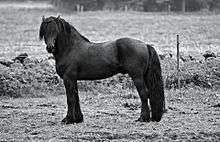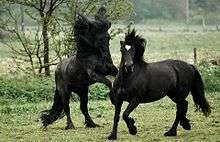North Swedish Horse
The North Swedish Horse (Swedish: 'Nordsvensk Brukshäst') is a Swedish breed of small heavy horse. It is closely related to the similar Dølehest breed of Norway.[4]:282 It was traditionally used for forestry and agricultural work. Lighter lines are bred for harness racing, and are registered in the stud-book of the Svensk Kallblodstravare (Swedish Coldblood Trotter).[2]:482[5]
 | |
| Conservation status | FAO (2007): not at risk[1]:112 |
|---|---|
| Other names | |
| Country of origin | Sweden |
| Use |
|
| Traits | |
| Weight | |
| Height | |
| Colour | any |
History and breeding
Nowadays, breeding of the North Swedish Horse is strictly controlled, and the animals intended for breeding are thoroughly tested. The primary qualities desired in a breeding horse are good character, pulling capacity and fertility. The legs and hooves are examined by X-ray.[5]
Characteristics

The North Swedish horse is agile and easy to train. Its conformation is compact and robust, while being relatively light for a draft horse. Regarding its small size it is very strong and durable, and it has an energetic, long-strided trot. A typical character is gentle and willing. The breed is known for its longevity and great health.[5]
Use
The North Swedish Horse is one of the few cold-blood breeds used in harness racing.[5] A world record for coldblood trotters of 1:17.9 per kilometre was set in 2005 by Järvsöfaks, who is of part Swedish, part Norwegian lineage.[6][7] North Swedish Horses are well suited for agricultural and forestry work.[5] In Sweden they are popular for recreational equestrian activities.
References
- Barbara Rischkowsky, D. Pilling (eds.) (2007). List of breeds documented in the Global Databank for Animal Genetic Resources, annex to The State of the World's Animal Genetic Resources for Food and Agriculture. Rome: Food and Agriculture Organization of the United Nations. ISBN 9789251057629. Accessed July 2017.
- Valerie Porter, Lawrence Alderson, Stephen J.G. Hall, D. Phillip Sponenberg (2016). Mason's World Encyclopedia of Livestock Breeds and Breeding (sixth edition). Wallingford: CABI. ISBN 9781780647944.
- Nordsvensk Brukshäst/Sweden. Domestic Animal Diversity Information System of the Food and Agriculture Organization of the United Nations. Accessed July 2017.
- Elwyn Hartley Edwards (1994). The Encyclopedia of the Horse. London; New York; Stuttgart; Moscow: Dorling Kindersley. ISBN 0751301159.
- Lucy Turner (2008). "The unusual suspects". Horse & Rider (39): 124.
- "Järvsöfaks S-94-0413 at Sukuposti.net pedigree database" (in Finnish). Retrieved 15 September 2008.
- "Järvsöfaks (SE) at The Blood Bank pedigree database". Retrieved 24 March 2010.